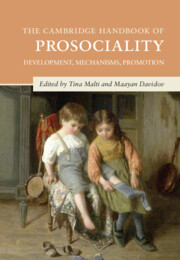Book contents
- The Cambridge Handbook of Prosociality
- Cambridge Handbooks in Psychology
- The Cambridge Handbook of Prosociality
- Copyright page
- Dedication
- Contents
- Figures
- Contributors
- Part I Development of Prosociality
- Part II Antecedents and Mechanisms of Prosociality
- 11 The Motives of Prosocial Behavior
- 12 Morality, Values, and Prosociality across Development
- 13 Emotions and Prosociality
- 14 Social-Cognitive Development and Early Prosocial Behavior
- 15 Temperament and Prosocial Behavior
- 16 Gender and Prosocial Development
- 17 Assessing Prosociality
- Part III Development of Prosociality in Context
- Part IV Applications
- Index
- References
13 - Emotions and Prosociality
from Part II - Antecedents and Mechanisms of Prosociality
Published online by Cambridge University Press: 25 May 2023
- The Cambridge Handbook of Prosociality
- Cambridge Handbooks in Psychology
- The Cambridge Handbook of Prosociality
- Copyright page
- Dedication
- Contents
- Figures
- Contributors
- Part I Development of Prosociality
- Part II Antecedents and Mechanisms of Prosociality
- 11 The Motives of Prosocial Behavior
- 12 Morality, Values, and Prosociality across Development
- 13 Emotions and Prosociality
- 14 Social-Cognitive Development and Early Prosocial Behavior
- 15 Temperament and Prosocial Behavior
- 16 Gender and Prosocial Development
- 17 Assessing Prosociality
- Part III Development of Prosociality in Context
- Part IV Applications
- Index
- References
Summary
Emotion motivates prosocial behavior, and interest in this topic usually focuses on empathy. This chapter explores other emotions that can also motivate prosocial action and the research directions and practical implications that follow. It opens with consideration of two perspectives on the association of emotions and prosocial behavior offered by Malti and Thompson, and then proceeds to discuss research concerning the following prosocial emotions: happiness derived from assisting another, moral pride derived from prosociality, indignation over observed harm, empathy and sympathy, and gratitude. Guilt as a moral and possibly prosocial emotion is also discussed. The shared element of these prosocial emotions is that they derive from a personal connection between an observer and another’s emotional experience. An overview of the research on emotional development and emotion regulation follows to explore how this connection emerges developmentally. The conclusion summarizes much-needed areas for further research along with the implications of these ideas.
- Type
- Chapter
- Information
- The Cambridge Handbook of ProsocialityDevelopment, Mechanisms, Promotion, pp. 256 - 274Publisher: Cambridge University PressPrint publication year: 2023



